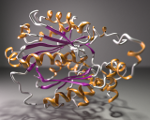Sculptor
Version 2.1
|
The latest release of
Sculptor includes multi-scale ambient occlusion illumination (Wahle and Wriggers, 2015) and the DPSV and VolTrac algorithms
for denoising and detecting filamentous densities (such as
alpha-helices and actin
filaments) in maps from EM and tomography (Starosolski
et al., 2012, Rusu
and Wriggers, 2012, Rusu
et al., 2012).
If
your OS is not supported:
|
|

The
previous major
release,
Sculptor Version 2.0, is available for download. A number of
new features
are introduced, including the following:
1. Multi-fragment
exhaustive search (using the MOSAEC
algorithm) and simultaneous off-lattice refinement (using
Sculptor's Refinement tool).
2. Scripting capabilities were added to Sculptor via the Lua
programming language.
3. Visualization is improved by supporting real-time ambient occlusion.
4. A new
PDF
user guide was created.
5.
Several
minor bugs in 1.2 were fixed. All functionalities of 1.2 (see below)
were retained.
Download Sculptor and PDF User
Guide
|
|
Sculptor
has been developed from at biomachina.org with
contributions from the following authors (in alphabetic order): Stefan
Birmanns, Maik Boltes, Paul Boyle, Jan Deiterding, Frank Delonge, Sayan
Ghosh, Jochen Heyd, Oliver
Passon, Mirabela Rusu, Francisco Serna, Zbigniew Starosolski, Manuel
Wahle, Willy
Wriggers, and Herwig Zilken.
|
|
Version 1.2
The
Sculptor 1.2 release supported
¨interactive global docking¨ peak search as a major new
feature,
but also
added programmable-GPU accelerated rendering of atomic models, other
smaller improvements and bug fixes.
Interactive Global Docking (IGD) is a novel technique that
enables an
interactive peak search in translation function scoring landscapes
generated from exhaustive docking
tools like Situs / colores (Situs release 2.5
supports IGD).
In experimental volumetric maps with a heterogeneous density
distribution, or significant areas that are not accounted for by the
atomic model, multi-resolution docking can be problematic. The correct
solution may be difficult for the automatic algorithms to detect, as
the docking contrast - the numerical difference of scores of false and
true positive solutions - can become very small. An interactive
screening of the scoring landscape allows the user to select carefully
the potential solutions, which then can be further optimized using an
off-lattice refinement technique. Please click on the image below to
see a video with the interactive global docking in action:
Programmable-GPU
accelerated rendering and
shading
of tube, cartoon and van-der-Waals representations. The new code is
optimized especially for low-end machines with inexpensive graphics
cards (for example netbooks with integrated Intel GMA950 graphics
chips, like the Asus EEE PC) and does not only lead to a higher-quality
representation, but at the same time also achieves a significantly
higher performance. Sculptor also enables the investigation
of pleiomorphic systems, especially in combination with the
efficient
flexible fitting technique which was introduced in Sculptor
1.1 / Situs
2.4.
Speed
improvements and code-cleanup in the
areas
of the cross-correlation coefficient calculation, loading and saving of
volumetric maps, display of the coordinate system and clipping planes.
Rendering under Microsoft Windows was improved.
Download
Sculptor and PDF User Guide
|
|
|